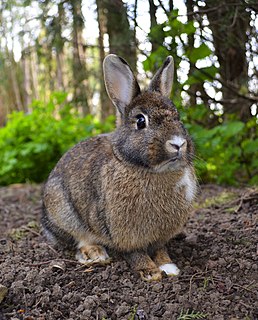
Rabbits, or bunnies, are small mammals in the family Leporidae of the order Lagomorpha. Oryctolagus cuniculus includes the European rabbit species and its descendants, the world's 305 breeds of domestic rabbit. Sylvilagus includes 13 wild rabbit species, among them the seven types of cottontail. The European rabbit, which has been introduced on every continent except Antarctica, is familiar throughout the world as a wild prey animal and as a domesticated form of livestock and pet. With its widespread effect on ecologies and cultures, the rabbit is, in many areas of the world, a part of daily life—as food, clothing, a companion, and a source of artistic inspiration.

Leporidae is the family of rabbits and hares, containing over 60 species of extant mammals in all. The Latin word Leporidae means "those that resemble lepus" (hare). Together with the pikas, the Leporidae constitute the mammalian order Lagomorpha. Leporidae differ from pikas in that they have short, furry tails and elongated ears and hind legs.

Cottontail rabbits are the leporid species in the genus Sylvilagus, found in the Americas. Most Sylvilagus species have stub tails with white undersides that show when they retreat, giving them their characteristic name. However, this feature is not present in all cottontails nor is it unique to the genus.

Sagebrush steppe is a type of shrub-steppe, a plant community characterized by the presence of shrubs, and usually dominated by sagebrush, any of several species in the genus Artemisia. This ecosystem is found in the Intermountain West in the United States.

The pygmy rabbit is a rabbit species native to the United States. It is also the only native rabbit species in North America to dig its own burrow. The pygmy rabbit differs significantly from species within either the Lepus (hare) or Sylvilagus (cottontail) genera and is generally considered to be within the monotypic genus Brachylagus. One isolated population, the Columbia Basin pygmy rabbit, is listed as an endangered species by the U.S. Federal government, though the International Union for Conservation of Nature lists the species as lower risk.

Brachylagus is a genus of lagomorph that contains the smallest living leporid, the pygmy rabbit. One extinct species, Brachylagus coloradoensis, is also known.

The Mexican cottontail is a species of cottontail rabbit in the family Leporidae. It is endemic to Mexico where its natural habitats are temperate forests, subtropical or tropical dry forests and pastureland.

Pine Valley Mountain Wilderness is a 50,232-acre (203.28 km2) wilderness area located in the Dixie National Forest in the U.S. state of Utah. It is the fourth-largest wilderness area located entirely within the state. The wilderness designation protects the Pine Valley Mountain range, a large rock outcrop surrounded by desert. The Pine Valley Mountains form the Pine Valley Laccolith, one of the largest laccoliths in the United States. Elevations in the wilderness range from 6,000 feet (1,800 m) to 10,365 feet (3,159 m) at the summit of Signal Peak.
The Columbia Basin pygmy rabbit is an isolated population of pygmy rabbit , that is native only to a single Columbia Basin area of Washington state. The Columbia Basin pygmy rabbit is the smallest North American rabbit. While the IUCN considers the species as a whole to be of least concern, the US Fish & Wildlife Service considers this a distinct population segment, and thus merits protections under the Endangered Species Act. The last purebred Columbia Basin pygmy rabbit died in 2008, marking the end of the pure genetic line.

The Beezley Hills are a range of hills, about 5 miles (8.0 km) north of Quincy in Grant County, Washington with a maximum elevation of 2,882 feet (878 m) or 2,886 feet (879.7 m).
Communal burrow refers to the habitat built by some species of mammals as a community habitat. There are some species that build burrows, but not communal burrows; and there are some species that live in communal groups, but do not construct burrows or any other type of habitat.








